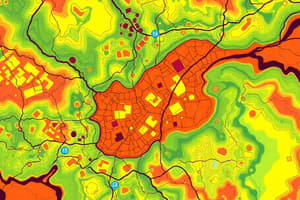Podcast
Questions and Answers
Which of the following is NOT a component of the Information Neighborhoods?
Which of the following is NOT a component of the Information Neighborhoods?
- News
- Entertainment
- Propaganda
- Privacy (correct)
What is the primary goal of propaganda?
What is the primary goal of propaganda?
Persuade
What is the goal of entertainment?
What is the goal of entertainment?
Divert, arouse, or move emotionally
What is the purpose of raw information?
What is the purpose of raw information?
What is the goal of advertising?
What is the goal of advertising?
Who are clients of news?
Who are clients of news?
Who are practitioners of news?
Who are practitioners of news?
What is one method used for news?
What is one method used for news?
What is considered an outcome of news?
What is considered an outcome of news?
What method is commonly used in propaganda?
What method is commonly used in propaganda?
Define the term 'bandwagon' in propaganda.
Define the term 'bandwagon' in propaganda.
What characterizes the term 'fake news'?
What characterizes the term 'fake news'?
The number of neighborhoods in the information framework is ____.
The number of neighborhoods in the information framework is ____.
Which political party is associated with the left?
Which political party is associated with the left?
What is the purpose of the circular reporting in media?
What is the purpose of the circular reporting in media?
What is the primary focus of publicity?
What is the primary focus of publicity?
Flashcards are hidden until you start studying
Study Notes
Information Neighborhoods
- Comprises six categories: News, Propaganda, Advertising, Publicity, Entertainment, and Raw Information.
- Each category serves unique purposes and targets different clients.
Media "Text"
- Includes various formats like advertisements, magazines, newspaper articles, television broadcasts, and video games.
Goals of Communication Types
- Propaganda: Aims to persuade.
- Entertainment: Intended to divert, arouse, or move emotions.
- Raw Information: Offers entertainment, personal expression, and bypasses verification.
- Advertising: Focused on selling products.
- News: Designed to inform.
- Publicity: Enhances the image of clients.
News Characteristics
- Clients: The Public.
- Practitioners: Journalists.
- Methods: Emphasizes verification, independence, and accountability.
- Outcome: Creates reliable and actionable information, fostering an informed society.
Propaganda Overview
- Clients: Governments and political parties.
- Definition: Spread of information, ideas, or rumors to influence perceptions or actions.
- Methods involve manipulation of information through various techniques such as Assertion, Bandwagon, and Card stacking.
Techniques of Propaganda
- Assertion: Statements presented as facts without evidence.
- Bandwagon: Encourages following the majority for perceived success.
- Card Stacking: Selective omission of negative information about an idea.
- Glittering Generalities: Uses vague words that elicit positive associations.
- Lesser of Two Evils: Presents a choice as the least harmful option.
- Name Calling: Employs derogatory terms to discredit opponents.
- Pinpointing the Enemy: Simplifies situations by identifying a clear antagonist.
- Plain Folks: Conveys a sense of camaraderie with the average person.
- Simplification: Reduces complex issues to binary choices.
- Testimonials: Endorsements linking respected figures to products or ideas.
- Transfer: Associates positive or negative feelings from one entity to another.
Clients and Practitioners of Other Communication Types
- Advertising: Client is Businesses; practitioners include agencies and ad directors.
- Publicity: Clients are celebrities and public officials; practitioners are public relations agencies.
- Entertainment: Clients are the public; practitioners include entertainers and creatives.
- Raw Information: Available to anyone, with no filtration or added context.
Newsworthiness Factors
- Impact, Immediacy, Proximity, Prominence, Novelty, Conflict, and Emotions determine a story's appeal.
Media and Political Spectrums
- Conservative is associated with right-wing politics; associated parties include Republicans.
- Liberal aligns with left-wing politics; associated parties include Democrats.
- Media outlets span a spectrum from MSNBC (far left) to FOX News (far right), with networks like NPR in the moderate category.
Media Bias Factors
- Political correctness, institutional bias, and audience bias contribute to perceived leanings in news coverage.
Understanding Fake News
- Defined as misinformation published as news to mislead consumers, often propagated through circular reporting.
Key Questions for Media Literacy
- Essential inquiries include: What do I know? How do I know? What don't I know?
Political Socialization
- A lifelong process influenced by family, education, peers, and media, shaping individuals' political views.
News Literacy Principle
- Recognizing the neighborhood of the information source is crucial for navigating media content effectively.
Studying That Suits You
Use AI to generate personalized quizzes and flashcards to suit your learning preferences.




